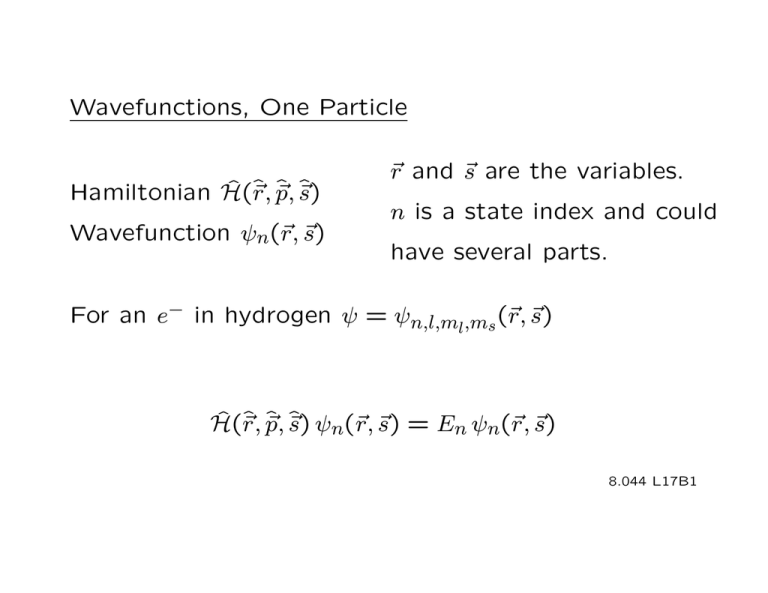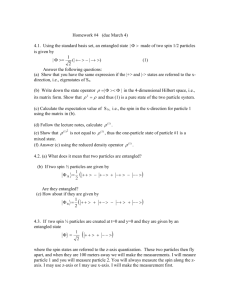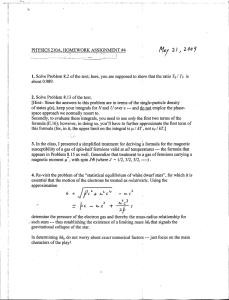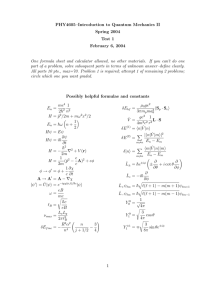Wavefunctions, One Particle Hamiltonian ψ r
advertisement

Wavefunctions, One Particle
Hamiltonian Ĥ(r̂
r, p,
r̂ r̂s)
r, rs)
Wavefunction ψn(r
r and rs are the variables.
n is a state index and could
have several parts.
For an e− in hydrogen ψ = ψn,l,ml,ms (r
r, rs)
Ĥ(r̂
r, p,
r̂ r̂s) ψn(r
r, rs) = En ψn(r
r, rs)
8.044 L17B1
ψn(r
r, rs) often factors into space and spin parts.
space
spin
ψn(r
r, rs) = ψn
(r
r) ψn
s)
J
JJ (r
space
ψn
space
ψn
(x) ∝
√
2 /2
−αx
e
Hn( α x)
(r
r) ∝
rk·r
i
e r
H.O. in 1 dimension
free particle in 3 dimensions
8.044 L17B2
spin
ψn
s)
;; (s
Spin is an angular momentum so for a given value of
the magnitude S there are 2S + 1 values of mS .
For the case of S = 1/2 the eigenfunctions of the z
component of s are φ1/2(ss) and φ−1/2(ss)
h̄
φ1/2(ss)
Ŝz φ1/2(ss) =
2
h̄
Ŝz φ−1/2(ss) = − φ−1/2(ss)
2
8.044 L17B3
spin
ψn
s) is not necessarily an eigenfunction of Ŝz . For
)) (s
example one might have
spin
ψn
s) = √1 φ1/2(ss) + √1 φ−1/2(ss)
)) (s
2
2
In some cases ψn(s
r, s) may not factor into space and
spin parts. For example one may find
ψn(x, s) = f (x) φ1/2(ss) + g(x) φ−1/2(ss)
8.044 L17B4
Many Distinguishable Particles, Same Potential,
No Interaction
Lump space and spin variables together
r1, rs1 → 1 r2, rs2 → 2 etc.
Ĥ(1, 2, · · · N ) = Ĥ0(1) + Ĥ0(2) + · · · Ĥ0(N )
In this expression the single particle Hamltonians all
have the same functional form but each has arguments
for a different particle.
8.044 L17B5
The same set of single particle energy eigenstates is
available to every particle, but each may be in a dif­
ferent one of them. The energy eigenfunctions of the
system can be represented as products of the single
particle energy eigenfunctions.
ψ{n}(1, 2, · · · N ) = ψn1 (1)ψn2 (2) · · · ψnN (N )
{n} ≡ {n1, n2, · · · nN }. There are N #s, but each ni
could have an infinite range.
Ĥ(1, 2, · · · N ) ψ{n}(1, 2, · · · N ) = E{n} ψ{n}(1, 2, · · · N )
8.044 L17B6
Many Distinguishable Particles, Same Potential,
Pairwise Interaction
Ĥ(1, 2, · · · N ) =
N
i=1
Ĥ0(i) +
1 Ĥint(i, j)
2
i=
j
The ψ{n}(1, 2, · · · N ) are no longer energy eigenfunc­
tions; however, they could form a very useful basis set
for the expansion of the true energy eigenfunctions.
8.044 L17B7
Indistinguishable Particles
P̂ij f (· · · i · · · j · · ·) ≡ f (· · · j · · · i · · ·)
(P̂ij )2 = Iˆ
⇒
eigenvalues of
P̂ij are + 1, −1
It is possible to construct many-particle wavefunctions
which are symmetric or anti-symmetric under this in­
terchange of two particles.
P̂ij ψ (+) = ψ (+)
Pˆij ψ (−) = − ψ (−)
8.044 L17B8
Identical ⇒ no physical operation distinguishes be­
tween particle i and particle j. Mathematically, this
means that for all physical operators Ô
[Ô, P̂ij ] = 0 ⇒ eigenfunctions of Ô must also be eigenfunctions of
P̂ij .
(+)
⇒ energy eigenfunctions ψE must be either ψE
(−)
ψE .
or
8.044 L17B9
⇒ states differing only by the interchange of the spa­
tial and spin coordinates of two particles are the same
state.
Relativistic quantum mechanics requires
integer spin ↔ ψE (+)
half-integer spin ↔ ψE (−)
[Bosons]
[Fermions]
8.044 L17B10
Composite Particles
• Composite Fermions and Composite Bosons
• Count the number of sign changes as all the con­
stituents are interchanged
• Well defined statistics (F-D or B-E) as long as the
internal degrees of freedom are not excited
8.044 L17B11
The constitutents of nuclei and atoms are e, p & n.
Each has S = 1/2.
N even ⇒ even # of exchanges.
ψ → (+)ψ ⇒ B-E
also N even ⇒ integer spin
N odd ⇒ odd # of exchanges.
ψ → (−)ψ ⇒ F-D
also N odd ⇒ half-integer spin
8.044 L17B12
Particle Nuclear Spin Electrons Statistics
H (H1)
D (H2)
T (H3)
He3
He4
1
2
1
1
2
1
2
0
1
1
1
B-E
F-D
B-E
2
2
F-D
B-E
F-D
B-E
B-E
B-E
Li6
Li7
1
3
2
3
3
H2
x2
0 or 1
integer
2
()×2
8.044 L17B13
Let α(r
r, rs), β(r
r, rs), · · · be single particle wavefunctions.
A product many-particle wavefunction, α(1)β(2), does
not work.
Instead, use a sum of all possible permutations:
(+)
Ψ2
(+)
ΨN
= √1 (α(1)β(2) + α(2)β(1))
2
=
√1 √1
(α(1)β(2)γ(3) · · ·)
permutations
n
!
N!
α α
8.044 L17B14
The antisymmetric version results in a familiar form,
a determinant.
(−)
Ψ2
(−)
ΨN
= √1 (α(1)β(2) − α(2)β(1))
2
=
1
√
N ! → states
α(1) β(1) γ(1)
α(2) β(2) γ(2)
α(3) β(3) γ(3)
..
..
..
· · · · · · · · · ↓ particles
8.044 L17B15
(−)
• ΨN
= 0 if 2 states are the same since 2 columns
are equal: Pauli Principle.
(−)
• ΨN
= 0 if 2 particles have the same r and rs since
2 rows are equal.
• Specification: indicate which s.p. ψs are used.
{nα, nβ , nγ , · · ·} An ∞ # of entries, each ranging
from 0 to N but with
α nα
= N.
8.044 L17B16
|1, 0, 1, 1, 0, 0, · · ·)
Fermi-Dirac
|2, 0, 1, 3, 6, 1, · · ·)
Bose-Einstein
'
α
Eαnα = E
Prime indicates
α
nα = N
Example Atomic configurations
(1S)2(2S)2(2P )6 ↔ Ne
(1S)2(2S)2(2P )6(3S)1 ↔ Na
(1S)1(2S)1 ↔ He*
8.044 L17B17
Statistical Mechanics Try Canonical Ensemble
Z(N, V, T ) =
e−E(state)/kT
states
=
I
e−E({nα})/kT
{nα}
=
I
{nα}
e−Eαnα/kT
α
This can not be carried out. One can not interchange
the
over occupation numbers and the
over states
because the occupation numbers are not independent
( nα = N ).
8.044 L17B18
T=0 LOWEST POSSIBLE TOTAL ENERGY
BOSE: ALL N PARTICLES IN LOWEST ε SINGLE PARTICLE STATE
nα( ε)
Nδ( ε)
ε
FERMI: LOWEST N SINGLE PARTICLE STATES EACH USED ONCE
ε < εF, εF CALLED THE FERMI ENERGY
nα( ε)
1
εF
ε
8.044 L17B19
MIT OpenCourseWare
http://ocw.mit.edu
8.044 Statistical Physics I
Spring 2013
For information about citing these materials or our Terms of Use, visit: http://ocw.mit.edu/terms.






